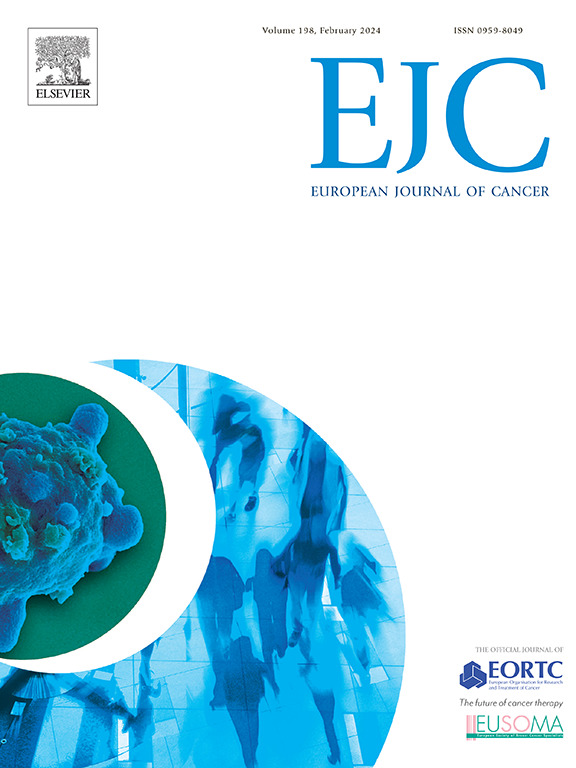Feasibility analysis of using patient-derived tumour organoids for treatment decision guidance in locally advanced head and neck squamous cell carcinoma
IF 7.6
1区 医学
Q1 ONCOLOGY
引用次数: 0
Abstract
Background
Current treatment for head and neck squamous cell carcinoma (HNSCC) involves surgery, radiotherapy, and chemotherapy. Despite aggressive multimodal approaches, tumour recurrence occurs in 40–60 % of cases, leading to poor survival outcomes. HNSCC lacks common genetic drivers for tailored therapies, and reliable biomarkers for treatment selection are scarce. We investigated the procedural requirements for incorporating drug- and radiosensitivity screens in patient-derived organoids (PDOs) within a clinical trial framework.
Patients and methods
Fresh tumour samples (N = 198) from 186 HNSCC patients were included. Success rates of organoid establishment were correlated with clinical and procedural parameters. Timelines for establishment of PDO cultures were determined, and their long-term growth potential assessed by serial passaging. Additionally, we conducted whole exome sequencing on matched tumour-organoid pairs. Three PDO models were employed to establish radiosensitivity assays.
Results
In total, PDO models displaying histomorphological features and genomic alterations of parental tumours were successfully established for 35 % of patient tumours. Success rates rose to 77 % for samples with a tumour cell content of 30 % or higher. Advanced patient age, prior radiotherapy, and delays in tissue processing were identified as negative predictors for engraftment. The estimated time interval needed for screens was compatible with PDO-guided selection of curative-intent radiotherapy regimens.
Conclusions
Our findings suggest that with high-quality samples and efficient tissue processing, PDO screens can be successfully performed in 77 % of HNSCC patients. Given the procedural challenges involved, future clinical trials aiming to the utility of PDOs for guiding treatment decisions should consider implementing centralised PDO screening.
在局部晚期头颈部鳞状细胞癌治疗决策指导中使用患者衍生肿瘤器官组织的可行性分析。
背景:目前治疗头颈部鳞状细胞癌(HNSCC)的方法包括手术、放疗和化疗。尽管采取了积极的多模式治疗方法,但仍有40-60%的病例出现肿瘤复发,导致患者生存率低下。HNSCC 缺乏可用于定制疗法的常见基因驱动因素,而用于治疗选择的可靠生物标志物也非常稀缺。我们研究了在临床试验框架内将药物和放射敏感性筛选纳入患者衍生有机体(PDOs)的程序要求:纳入了 186 名 HNSCC 患者的新鲜肿瘤样本(N = 198)。类器官建立的成功率与临床和程序参数相关。确定了PDO培养物的建立时间,并通过连续传代评估了其长期生长潜力。此外,我们还对匹配的肿瘤-类器官对进行了全外显子组测序。我们采用了三种 PDO 模型来建立放射敏感性测定:结果:总共有 35% 的患者肿瘤成功建立了显示亲代肿瘤组织形态学特征和基因组改变的 PDO 模型。肿瘤细胞含量达到或超过30%的样本的成功率上升到77%。高龄患者、曾接受过放疗和组织处理延迟被认为是影响移植的不利因素。筛查所需的估计时间间隔符合PDO指导下的治疗性放疗方案选择:我们的研究结果表明,通过高质量的样本和高效的组织处理,77% 的 HNSCC 患者可以成功进行 PDO 筛查。考虑到所涉及的程序挑战,未来旨在利用 PDO 指导治疗决策的临床试验应考虑实施集中式 PDO 筛查。
本文章由计算机程序翻译,如有差异,请以英文原文为准。
求助全文
约1分钟内获得全文
求助全文
来源期刊

European Journal of Cancer
医学-肿瘤学
CiteScore
11.50
自引率
4.80%
发文量
953
审稿时长
23 days
期刊介绍:
The European Journal of Cancer (EJC) serves as a comprehensive platform integrating preclinical, digital, translational, and clinical research across the spectrum of cancer. From epidemiology, carcinogenesis, and biology to groundbreaking innovations in cancer treatment and patient care, the journal covers a wide array of topics. We publish original research, reviews, previews, editorial comments, and correspondence, fostering dialogue and advancement in the fight against cancer. Join us in our mission to drive progress and improve outcomes in cancer research and patient care.
 求助内容:
求助内容: 应助结果提醒方式:
应助结果提醒方式:


